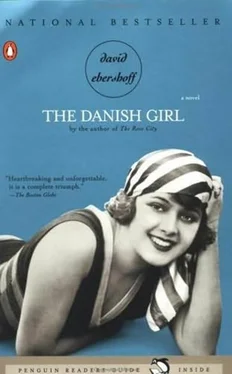The living room was small, arranged with a settee with gold legs and a tapestry pattern on the cushion. There was a slim vase of tiger lilies, the buds veined and green. A maid in black uniform was serving lemonade and anisette. A man, tall and oddly dressed in a dark overcoat, was standing behind the chair.
“This is Professor Bolk,” Anna said.
“I guessed that,” Greta said. “But aren’t you warm?”
“Professor Alfred Bolk.” He offered his hand. “For some reason, I’m always a bit cold,” he said, shaking his shoulders slightly in his coat. His blue eyes were dark and flecked with gold. He had hair like the dark blond of good wood, oiled back over his head so that it curled up at his neck. He was wearing a blue silk tie with a large knot and a diamond pin. His calling cards he carried in a silver case. He was from Dresden, where he ran the Municipal Women’s Clinic.
The maid served Professor Bolk coffee poured over ice. “I can’t take lemon,” he explained, lifting his glass. There was a breeze from the terrace door, and Greta sat next to the professor on the sofa. He smiled politely, his shoulders up. She supposed she should wait for him to ask questions, but she suddenly felt a need to tell someone about Lili and Einar. “It’s about my husband,” she began.
“Yes, I understand there’s a certain little girl named Lili.”
So he knew. At first, Greta didn’t know what to say. Yes, where to begin? Had it all started that day four years ago when she asked him to try on Anna’s shoes? Or was there something else? “He’s convinced he ’s a woman inside,” she said.
Professor Bolk made a small noise of sucking air between his teeth. He nodded quickly.
“And to tell the truth,” Greta said, “so am I.” She described the short-sleeved dresses and the sennep -yellow shoes and the specially sewn camisole; she reported on Einar’s outings to the Bains du Pont-Solférino and the shopping sprees at Bon Marché on the rue du Bac. She spoke of Henrik and Hans and the few other men over whom Lili’s heart had swollen up and burst with a pinprick of frustration. She said, “She’s quite beautiful, Lili is.”
“These men… this Hans… is there anything else I should know?”
“Not really.” She thought of Hans, who probably that very minute was hanging the camellia portrait in his gallery. It didn’t happen very often, but nothing disappointed her more than when Hans stopped by the studio and, with his fingers rubbing his chin, rejected a painting. “Not good enough,” he’d say two, three times a year, shocking Greta, leaving her incapable of moving, of seeing Hans to the door. Sometimes, when the world was quiet, she wondered if such crushing disappointment could be worth it.
It had been Anna who first mentioned a doctor. “Should he maybe see someone?” she said one day. She and Greta were in a frame store down the street from the Oscar Wilde hotel. There were bins of old frames, some that weighed over one hundred pounds. The frames were dusty, dirtying their skirts. Then she said, “I’m worried about him.”
“I told you what happened with Hexler back in Denmark. I don’t know if he could take another doctor. It might crush him.”
“Doesn’t it concern you just a little? About how ill he looks? How thin he’s become? It sometimes seems he’s hardly there at all.”
Greta thought about this. Yes, Einar looked pale to her, with thin blue pads spreading beneath his eyes. A translucence had developed in his skin. Greta had seen this, but had it worried her, more than everything else? And the bleeding, returning irregularly for more than four years now. She ’d learned to live with him, with his transformation. Yes, it was as if Einar were on a perpetual track of transformation, as if these changes-the mysterious blood, the hollow cheeks, the unfulfilled longing-would never cease, would lead to no end. And when she thought about it, who wasn’t always changing? Wasn’t everybody always turning into someone new? In a bin with a chained lid, Greta found the perfect frame, its lip painted gold, for her latest painting of Lili. “But if you know someone,” she said to Anna, “if you have a doctor in mind, maybe I should talk to him. It couldn’t hurt, could it?”
Professor Bolk said, “I’d like to examine your husband.” This made Greta think of Hexler and his clanging X-ray machine. She wondered if Einar would ever let her take him to another doctor. Professor Bolk sipped his coffee, and pulled a notepad from his pocket.
“I don’t think your husband is insane,” the professor offered. “I’m sure other doctors will tell you your husband’s insane. But that’s not what I think.” There was a painting of Lili in Anna’s living room. It showed her on a bench in a park. Behind her two men were talking, their hats in their hands. The painting hung above a side table full of silver-framed photographs of Anna, in wig and costume, hugging friends after performances. Greta had painted the park scene the year before, when Lili would show up at the casita and stay for three weeks and then disappear for another six, and when Greta was learning to work and live more and more without her husband. For a while the year before, when he refused to speak to her except as Lili, she herself had thought he had gone insane. He’d taken on a look, which came and went, of trance: eyes so dark that all she could see in them was a reflection of herself.
“I’ve met another man like him,” Professor Bolk said. “A tram conductor. A young man, handsome enough, pretty even, slender, pale of course, a bit light on his feet. Nervous man, but who could blame him for that, what with his situation? He came to see me, and the first thing I noticed-how could I not?-was that he had breasts bigger than many teenage girls. By the time he came to see me he ’d started calling himself Sieglinde. It was peculiar. One day he arrived at the clinic begging to be admitted. The other doctors said we couldn’t admit a man to the Municipal Women’s Clinic. They refused to examine him. But I agreed to, and one afternoon-I’ll never forget it-I discovered he was both male and female.”
Greta thought about what this might mean, about the horrible sight of what must have lay lifelessly, like the extra flesh on the very old, between the man’s legs. “What did you say to him?” she asked.
The breeze lifted the drapes, and there was the sound of boys playing tennis; then their mother calling them inside.
“I told him I could help him. I told him I could help him choose.”
There was a part of Greta that wanted to ask, “Choose what?” At once, she knew and didn’t know the answer. For even Greta, who recently had often thought to herself, Oh, if only Einar could choose who he wanted to be… for even Greta could not imagine that a real choice was possible. She sat on the gold-legged sofa and thought about Einar, who in some ways no longer existed at all. It was as if someone-yes, someone-had already chosen for him.
“What happened to the man?” asked Anna.
“He said he wanted to be a woman. He said all he wanted was to be loved by a man. He was willing to do anything for it. He came to me in my office, wearing a felt hat and a green dress. He carried a pocket watch like a man, I remember, because he pulled it out during our meeting and kept looking at it, saying he had to go because he had come to splitting his days in half, living the mornings as a woman and the afternoons as a man.
“This was many years ago, when I was still a young surgeon. Technically I knew exactly what I could do for him. But I had never performed such complicated surgery, not then. And so for a month I stayed up at night reading medical texts. I attended amputations, studied sutures. Anytime a woman at the clinic had her uterus removed, I watched in the operating amphitheater. Then I’d study the specimen in our laboratory. Finally one day, when I was ready, I told Sieglinde I wanted to schedule a surgery.
Читать дальше












